I got the biggest check of my career and got into the Masters. Even though it wasn’t a win, it was a win. – Daniel Summerhays, on his third-place finish last year at the PGA Championship
KAYSVILLE — Lest anyone think that the magnitude of going to the Masters might be lost on Daniel Summerhays, consider this: not only can he hum the tune to the Masters theme song, he knows all the words.
For proof, he pulls out a cassette tape — remember them? — and pops it into a player. Sure enough, there are the familiar tranquil chords the world hears just before CBS's Jim Nantz says, “Hello friends, welcome to Augusta National and the Masters,” followed by something you don’t hear on television:
Oh, Augusta
Your dogwoods and pines
They play on my mind like a song
Oh, Augusta
It’s you that I love
It’s you that I miss when I’m gone
Summerhays sings the words right along with the music. Not many people even know the Masters song has lyrics, but he does. He was 8 years old when his mother, Ann, gave him the tape he’s holding in his hands. She and his dad, Lynn, had just returned from watching the 1992 Masters, the one Fred Couples won when his tee shot inexplicably stayed out of Raes Creek on 12. Ann Summerhays, no stranger to watching golf tournaments, was sufficiently enamored by the experience — “There’s just such a beauty there; almost a sacredness” — that she tracked down the music and made a cassette for everyone in the family.
While other kids were playing Guns N’ Roses and Boyz II Men in their Walkmans, Danny Summerhays was popping the Masters theme song into his.
“It was written by Dave Loggins; he’s Kenny Loggins’ cousin,” Danny announces, displaying yet more depth on the subject. “My wife can play it on the piano.”
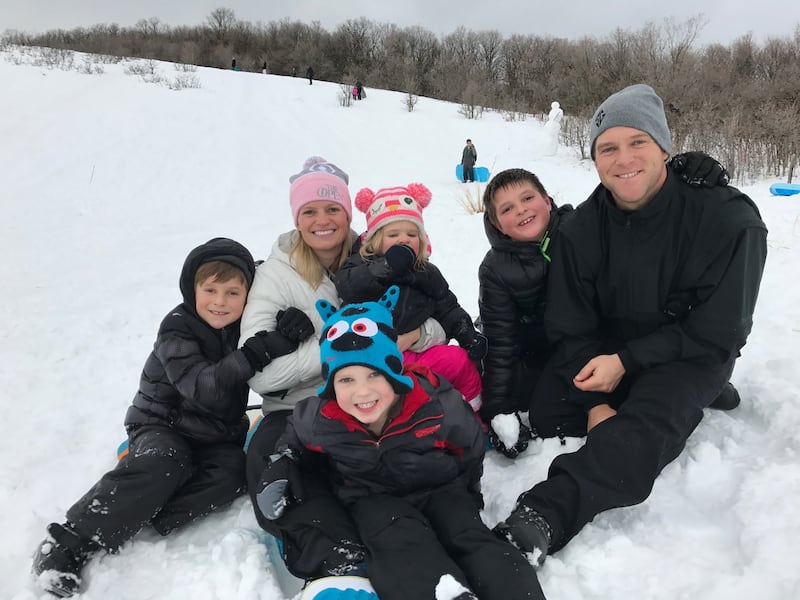
Professional golfer Daniel Summerhays with his wife Emily and their four children, Jack, William, Lydia and Patton. | Courtesy Summerhays family
Summerhays, 33, is sitting in the home he shares with his wife, Emily, and their four children that lies just across the gully from the Davis County Golf Course in Kaysville. It’s the home the PGA Tour bought — a testament to just how good golf, and life, have been to him. There’s a basketball court in the basement that doubles as a pickleball court — his second favorite sport — and as an indoor driving range so he can work on his game when there’s a blizzard outside.
He’s made a living playing golf for 10 years now. A chart of his steady growth looks like a snapshot of Apple stock. He’s played in 177 PGA Tour events and won $9 million. Last year alone he topped $2 million. He’s qualified for the FedEx Cup — golf’s playoffs — for the past five years straight. Currently, he’s ranked 87th in the world. He’s played in the U.S. Open twice, the PGA Championship three times and the Open Championship. Golf has taken him almost everywhere.
Only the Masters — the toughest tournament in the world to get into, an invitation-only competition that in its 84-year history has welcomed just five other native-born Utahns (amateur Clay Ogden, Jay Don Blake, Billy Johnston, George Von Elm and George Schneiter Sr.) — has eluded him.
But that all changed last August, when he made six birdies on the last 10 holes of the PGA Championship at Baltusrol. The surge wasn’t quite enough to catch Jimmy Walker, the winner, or Jason Day, the runner-up, but it was enough to finish third in a major championship where the top four qualify for the Masters.
“I got the biggest check of my career and got into the Masters,” says a beaming Summerhays. “Even though it wasn’t a win, it was a win.”
To appreciate where the overriding quest to make it to the Masters, let alone the compulsion to learn all the lyrics to the theme song, comes from, it helps to go back to a house of considerably smaller size on the east side of Salt Lake City where Daniel’s grandparents, Pres and Margaret Summerhays, raised their three sons, Bruce, Lynn and Gary.
Pres Summerhays was coaching at the University of Utah when he bought the house on 1800 East. A star football and baseball player at the U. during his playing days, Pres was literally a coach for all seasons, an assistant on the Utes’ football and baseball staffs and head coach of the ski and golf teams. His boys liked all the sports, but golf grabbed them especially hard at a young age, not least because their house backed onto the grounds of the Salt Lake Country Club.
The Summerhayses were not members of the country club — college coaches did not make seven figures, or even six figures, in 1960 — but the path behind their house led directly to a maintenance gate, which was padlocked, but with a gap that, as Lynn Summerhays recalls, “was just big enough for little bodies to slip right through.”
When it was growing dark, after members had passed on to complete their rounds, Bruce, Lynn and Gary, like ferrets, would emerge to chip and putt balls on the country club greens. “We won every major championship about 200 times as the sun set on the ninth (now 14th) green, and we raised our arms triumphantly going back up the hill,” remembers Lynn. “We may have needed four or five putts to do it, to beat Arnie and Jack and Gary and the rest, but we’d do it.”
The Summerhays boys all went on to play on the golf team at the University of Utah. After college, Bruce and Gary followed their father’s footsteps into coaching — Gary at high schools in California, and Bruce — who in his 50s would star on the Champions Tour, winning three times and amassing $9 million in earnings — at Stanford University. Lynn went on to get a master’s degree in administration from George Washington University and made his way in the real estate world.
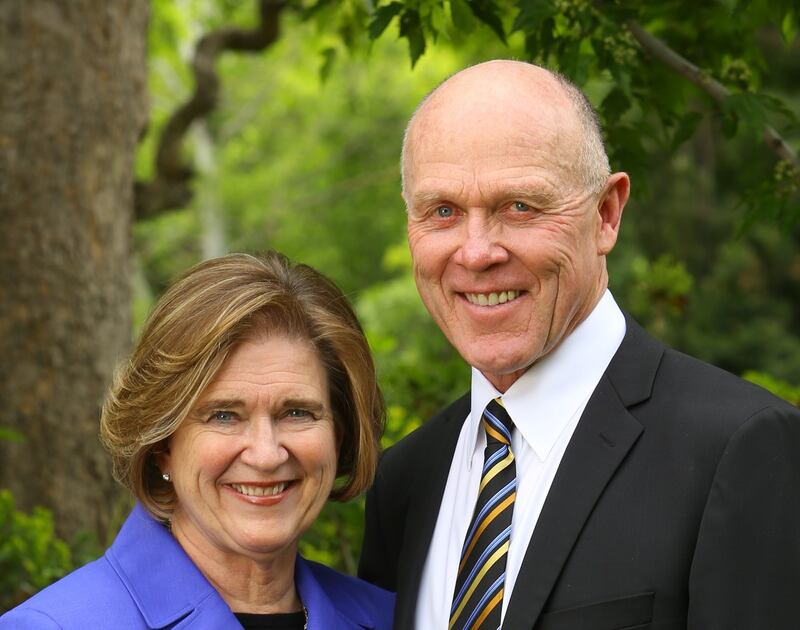
Ann F. and Lynn L. Summerhays, parents of Daniel Summerhays. | Courtesy Summerhays family
By the time they each got married and started having families of their own — Gary had 12 kids, Bruce eight and Lynn seven — golf was as much a part of growing up a Summerhays as talking, walking and tying your shoes.
Of those 27 cousins, all played some form of competitive golf. For 17 straight seasons, one Summerhays or another, and sometimes as many as 11, competed in San Diego during the annual Junior World championships there. No less than eight went on to play in college on scholarship, including Bruce’s sons Brian and Bruce Jr. at the University of Utah; Bruce’s son Joseph and daughter Carrie at BYU; Gary’s daughter Hannah at BYU; and Lynn’s sons Boyd at Oklahoma State, and David and Daniel at BYU. Besides Bruce Sr., Boyd played on the PGA Tour, as did Carrie on the LPGA Tour. Today, Joseph, Bruce Sr. and Hannah make their living as golf pros, while Carrie is head women’s golf coach at BYU and Boyd coaches several top PGA Tour players, including, besides his brother, Utahn Tony Finau.
Daniel’s place in this parade is at the end of the line. Of the 15 Summerhays cousins — Lynn’s kids and Bruce’s kids — who were virtually inseparable growing up in Utah, the ones who habitually spent summer and Christmas vacations on golf trips together, he is No. 15. Every time Danny — who they say is a dead ringer for his stocky, muscular grandfather — looked up, somebody was shooting par. Somebody he was related to.
He was 4 years old when he played his first competitive round of golf. He wasn’t supposed to. He was along for the ride, literally, to a junior tournament his older siblings and cousins had entered in Richfield.
But he kept begging his mother, who kept saying no, until the tournament director cut in and said, “Oh, Ann, let him go play.”
“So he played, and he played fine,” remembers Ann. “It was a two-day tournament. The second morning he woke up and he said, ‘Do I have to play? I’m so tired.’ I told him no, he didn’t have to.”
But the ball was rolling, and there was no slowing it down.
“I am the beneficiary of a huge trickle-down effect, no question,” agrees Daniel, whose family joined Oakridge, the country club just around the corner from their home in Farmington, in 1983, the same year he was born. From then on, they could all walk in through the front gate.
The Summerhayses were not stereotypical one-dimensional country club kids. Daniel was an Eagle Scout, participated in church youth activities, carried a plus-4.0 GPA at Davis High, and played on the school’s state championship basketball team. But golf, always golf, was the family anchor. Lynn cut holes in the front lawn for chipping and putting. A picture of quintessential golf gentleman Bobby Jones — a copy of the original that hangs in the Butler Cabin at Augusta — hung in the living room next to the TV. “Golf was a way to raise our children,” says Ann Summerhays. “As a parent, there aren’t many sports you can hang out with your kids all summer, but you can with golf.”
Daniel followed most closely in the footsteps of Boyd, his older brother by four years and a genuine golf phenom. At 10, Boyd won a Junior World championship. At 16, Golfweek named him the national junior player of the year.
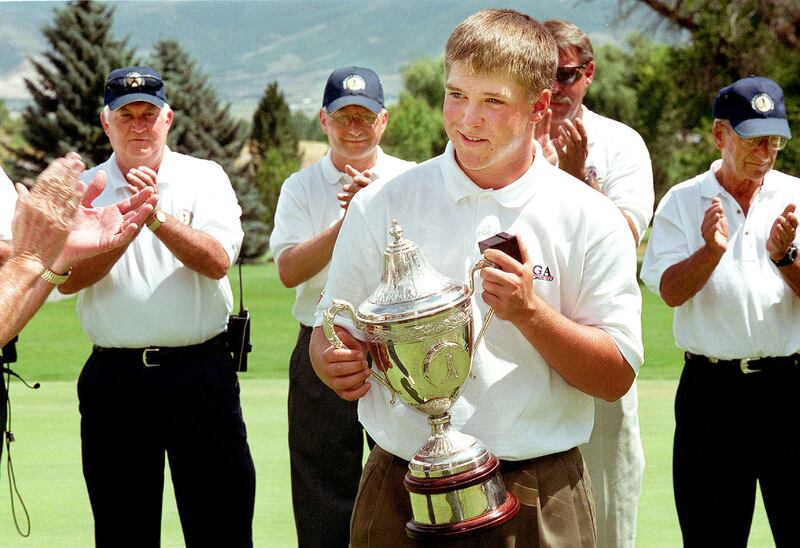
FILE: Daniel Summerhays accepts the trophy after winning the State Amateur golf finals at Wasatch Mountain Golf course in Midway on July 15, 2001. | Laura Seitz, Deseret News
Daniel slipped seamlessly into Boyd’s slipstream. At 16, he won the Utah State Amateur, crowned as not only the best young amateur in the state, but the best at any age. The next year he won the State Am again. BYU practically begged him to let them pay for his college education.
After one year competing for the Cougars, he accepted an LDS mission call to Chile — and took two years off from golf.
Not most of two years. All of two years. His entire time in Chile he did not so much as grip a club.
“Just never did,” says Daniel. “There are other things besides golf that will improve your game. The work ethic, the love and the value of service I learned in Chile was irreplaceable. It wasn’t hitting balls on the range, but after I got back my progression was exponential.”
In December 2005 he married Emily — they’d met at college before he went to Chile: another non-golf event that improved everything.
“A huge break in my life,” he says. “She lights up any room she walks into.”
The next big break came when, as a junior, he shot 63 in the final round of the NCAA regional tournament in Phoenix. The BYU team didn’t play well enough to qualify to move on to the national meet the next week, but, by virtue of that 63, Daniel did. He went on to place fourth as an individual in the NCAA finals, which in turn got him named first-team All-American, which in turn got him entry into the next week’s event on the Nationwide (now Web.com) Tour — the pro level just below the PGA Tour.
He teed it up in Columbus, Ohio, and won.
“Timing in golf is everything,” says Daniel. “If I don’t shoot that 63 (in Phoenix), who knows where I’d be.”
Because the win in Columbus gave him automatic entry into the Nationwide Tour, he forewent his senior season at BYU and turned pro. Three years of paying his dues later, he qualified for the PGA Tour beginning with the 2011 season.
His career path has been patience and persistence personified. He made $301,000 in prize money his first year, followed by $1.1 million in year two, then $1.2 million, $1.5 million, $1.6 million and $2.1 million in 2016.
Getting an outright win on the big tour has proved evasive, however. He has finished runner-up twice. His closest, and most excruciating, call came at the John Deere Classic in 2013, when he was poised for victory until his approach shot on the final hole plugged in a greenside bunker mere inches from safety. He had no shot at advancing the ball toward the hole and made bogey, allowing Jordan Spieth, who had earlier holed out from a more advantageous lie in that same bunker, to win his first event on the PGA Tour.
Losing that tournament cost Summerhays a ticket to the Masters (winners of PGA Tour events gain automatic entry to Augusta), but the biggest heartbreak came in 2015 when he was on the cusp of finishing among the top 30 players in the FedEx Cup finals, a distinction that carries with it a Masters invitation.
His round finished, he could only stand and watch as Harris English, needing a 20-foot putt from the fringe on the final green to knock Summerhays back to No. 31, stroked in the long putt.
The pathway to the Masters came in an unexpected way in 2016. At the U.S. Open at Oakmont, Summerhays was paired with South African Branden Grace in the final round, when Grace, who was in contention to finish among the top four, observed that fourth place or better in a major qualified for the Masters.
“I didn’t realize that,” says Summerhays, who tied for eighth at the Open. “But when we played the PGA, I was well aware.”
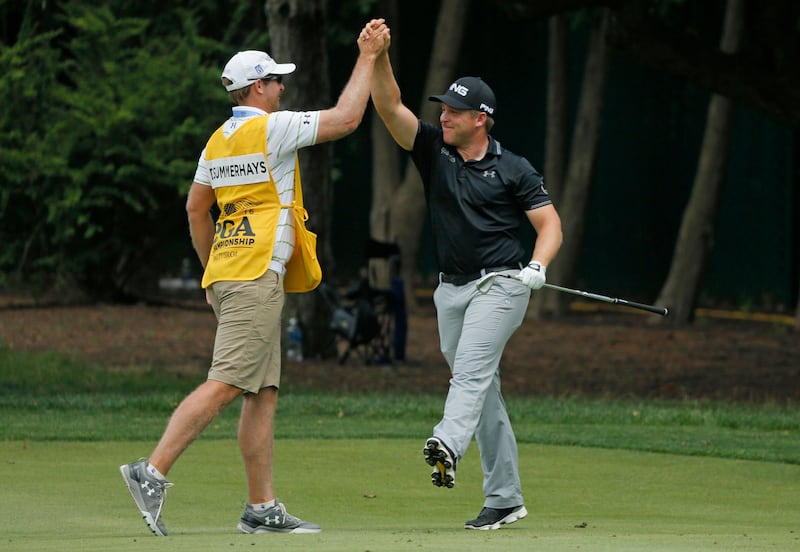
FILE: Daniel Summerhays, right, celebrates with his caddie Nick Jones, left, after making an eagle on the second hole during the third round of the PGA Championship golf tournament at Baltusrol Golf Club in Springfield, N.J., Saturday, July 30, 2016. | Tony Gutierrez, Associated Press
The PGA Championship was played a month later, at Baltusrol. As Summerhays came down the stretch and began his birdie run, he knew that two prizes were on the line: first, a major championship; second, a trip to another major championship.
Playing ahead of the leaders, he had to count on them backing up for him to win the tournament. But as for the Masters, that was all on him.
On the 18th hole, a par-5, he drove in ideal position in the fairway and was on the green in two. His eagle putt came up three inches short, but in addition to the $680,000 he would win for finishing third, that three-inch birdie putt had Augusta written all over it.
“People texted me afterward, saying how sorry they were I didn’t win,” says Daniel. “But there was no sadness for me. I got into the Masters, I think that counts as a win.”
The invitation arrived in the mail, very Augusta-like, on Jan. 2, 2017. It was addressed to Daniel Summerhays:
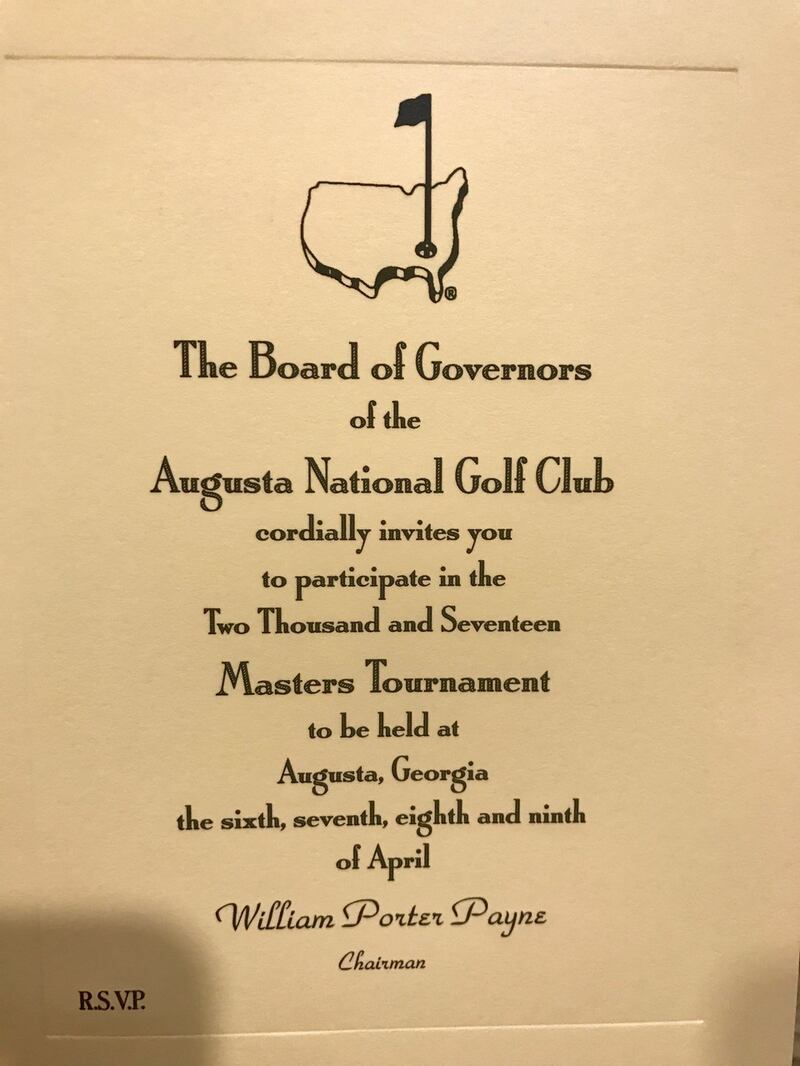
On the first of January, this invitation arrived in Daniel Summerhays's mailbox in Kaysville. | Courtesy Summerhays family
The Board of Governors
of the
Augusta National Golf Club
cordially invite you
to participate in the
Two Thousand and Seventeen
Masters Tournament
to be held at
Augusta, Georgia
The sixth, seventh, eighth and ninth
of April
It was signed by William Porter Payne, Chairman, and asked for an RSVP.
Daniel responded that very day.
In the Summerhays world, seismic shifts have been taking place ever since. They have rented three houses in Augusta for tournament week. Every one of Daniel’s siblings — David, Rebeccah, Elizabeth, Spencer, Boyd and Mary — will be there, along of course with Lynn and Ann, as well as several of their 28 grandkids, including Dan and Emily’s four, and Emily’s parents and assorted other relatives and friends.
Despite the fact that, other than the first one in 1934, only one first-timer has ever won the tournament — Fuzzy Zoeller in 1979 — Summerhays likes his chances. For one thing, he’s 33 — the average age of Masters winners. For another, he’s got a good track record playing in the majors. Of the five U.S. Opens, PGA Championships and British Opens he’s played in, he is yet to miss the cut, and he had the two top tens last year — the eighth-place finish at the U.S. Open (which earned him an exemption for this year’s Open) and the third-place finish at the PGA.
“I know my game, my personality, my mentality, is conducive to major championship golf,” he says. “I putted well at both the U.S. Open and PGA and that’s important.”
His uncle, Bruce Summerhays, the three-time Champions Tour winner, adds, “Daniel is the epitome of concentrating beautifully on the golf course. When it’s time to focus, he does that with the best of them.”
“It will be most historic for all of us, regardless of what happens,” says Lynn Summerhays. “If there is a divine orchestration — I think Ben Crenshaw would say heaven’s involved in this game — we view this as a sweet, sweet kind and tender mercy to have him there. We all can’t wait to touch the surface of Augusta.”
And then, waxing lyrical, Daniel’s dad adds, “We love those dogwoods and pines that play on your mind.”





























